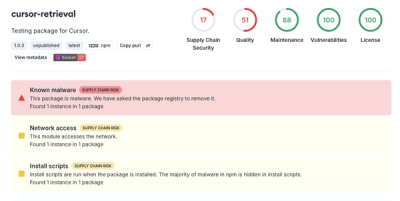
Security News
The Risks of Misguided Research in Supply Chain Security
Snyk's use of malicious npm packages for research raises ethical concerns, highlighting risks in public deployment, data exfiltration, and unauthorized testing.
An NPM installer for PhantomJS, headless webkit with JS API.
Pre-2.0, this package was published to NPM as phantomjs. We changed the name to phantomjs-prebuilt at the request of PhantomJS team.
Please update your package references from phantomjs to phantomjs-prebuilt
npm install phantomjs
Or grab the source and
node ./install.js
What this installer is really doing is just grabbing a particular "blessed" (by this module) version of Phantom. As new versions of Phantom are released and vetted, this module will be updated accordingly.
bin/phantomjs [phantom arguments]
And npm will install a link to the binary in node_modules/.bin as
it is wont to do.
The package exports a path string that contains the path to the
phantomjs binary/executable.
Below is an example of using this package via node.
var path = require('path')
var childProcess = require('child_process')
var phantomjs = require('phantomjs')
var binPath = phantomjs.path
var childArgs = [
path.join(__dirname, 'phantomjs-script.js'),
'some other argument (passed to phantomjs script)'
]
childProcess.execFile(binPath, childArgs, function(err, stdout, stderr) {
// handle results
})
The major and minor number tracks the version of PhantomJS that will be installed. The patch number is incremented when there is either an installer update or a patch build of the phantom binary.
Pre-2.0, this package was published to NPM as phantomjs. We changed the name to phantomjs-prebuilt at the request of PhantomJS team.
By default, this package will download phantomjs from our releases. This should work fine for most people.
If github is down, or the Great Firewall is blocking github, you may need to use
a different download mirror. To set a mirror, set npm config property phantomjs_cdnurl.
Alternatives include https://bitbucket.org/ariya/phantomjs/downloads (the official download site)
and http://cnpmjs.org/downloads.
npm install phantomjs --phantomjs_cdnurl=https://bitbucket.org/ariya/phantomjs/downloads
Or add property into your .npmrc file (https://www.npmjs.org/doc/files/npmrc.html)
phantomjs_cdnurl=https://bitbucket.org/ariya/phantomjs/downloads
Another option is to use PATH variable PHANTOMJS_CDNURL.
PHANTOMJS_CDNURL=https://bitbucket.org/ariya/phantomjs/downloads npm install phantomjs
If you plan to install phantomjs many times on a single machine, you can
install the phantomjs binary on PATH. The installer will automatically detect
and use that for non-global installs.
PhantomJS needs to be compiled separately for each platform. This installer finds a prebuilt binary for your operating system, and downloads it.
If you check your dependencies into git, and work on a cross-platform team, then you need to tell NPM to rebuild any platform-specific dependencies. Run
npm rebuild
as part of your build process. This problem is not specific to PhantomJS, and this solution will work for any NodeJS package with native or platform-specific code.
If you know in advance that you want to install PhantomJS for a specific architecture,
you can set the environment variables: PHANTOMJS_PLATFORM
(to set target platform) and PHANTOMJS_ARCH (to set target
arch), where platform and arch are valid values for
process.platform and process.arch.
PhantomJS is not a library for NodeJS. It's a separate environment and code written for node is unlikely to be compatible. In particular PhantomJS does not expose a Common JS package loader.
This is an NPM wrapper and can be used to conveniently make Phantom available It is not a Node JS wrapper.
I have had reasonable experiences writing standalone Phantom scripts which I then drive from within a node program by spawning phantom in a child process.
Read the PhantomJS FAQ for more details: http://phantomjs.org/faq.html
An extra note on Linux usage, from the PhantomJS download page:
There is no requirement to install Qt, WebKit, or any other libraries. It however still relies on Fontconfig (the package fontconfig or libfontconfig, depending on the distribution).
spawn ENOENTThis is NPM's way of telling you that it was not able to start a process. It usually means:
node is not on your PATH, or otherwise not correctly installed.tar is not on your PATH. This package expects tar on your PATH on Linux-based platforms.Check your specific error message for more information.
Error: EPERM or operation not permitted or permission deniedThis error means that NPM was not able to install phantomjs to the file system. There are three major reasons why this could happen:
npm cache clean to fix them.Error: read ECONNRESET or Error: connect ETIMEDOUTThis error means that something went wrong with your internet connection, and the installer was not able to download the PhantomJS binary for your platform. Please try again.
ECONNRESET or ETIMEDOUT consistently.Do you live in China, or a country with an authoritarian government? We've seen problems where the GFW or local ISP blocks github, preventing the installer from downloading the binary.
Try visiting the download page manually.
If that page is blocked, you can try using a different CDN with the PHANTOMJS_CDNURL
env variable described above.
You can tell NPM and the PhantomJS installer to skip validation of ssl keys with NPM's strict-ssl setting:
npm set strict-ssl false
WARNING: Turning off strict-ssl leaves you vulnerable to attackers reading
your encrypted traffic, so run this at your own risk!
If you install PhantomJS manually, and put it on PATH, the installer will try to use the manually-installed binaries.
nodeSome Linux distros tried to rename node to nodejs due to a package
conflict. This is a non-portable change, and we do not try to support this. The
official documentation
recommends that you run apt-get install nodejs-legacy to symlink node to nodejs
on those platforms, or many NodeJS programs won't work properly.
Questions, comments, bug reports, and pull requests are all welcome. Submit them at the project on GitHub. If you haven't contributed to an Medium project before please head over to the Open Source Project and fill out an OCLA (it should be pretty painless).
Bug reports that include steps-to-reproduce (including code) are the best. Even better, make them in the form of pull requests.
Dan Pupius (personal website) and Nick Santos, supported by A Medium Corporation.
Copyright 2012 A Medium Corporation.
Licensed under the Apache License, Version 2.0.
See the top-level file LICENSE.txt and
(http://www.apache.org/licenses/LICENSE-2.0).
FAQs
Headless WebKit with JS API
We found that phantomjs demonstrated a not healthy version release cadence and project activity because the last version was released a year ago. It has 3 open source maintainers collaborating on the project.
Did you know?

Socket for GitHub automatically highlights issues in each pull request and monitors the health of all your open source dependencies. Discover the contents of your packages and block harmful activity before you install or update your dependencies.

Security News
Snyk's use of malicious npm packages for research raises ethical concerns, highlighting risks in public deployment, data exfiltration, and unauthorized testing.

Research
Security News
Socket researchers found several malicious npm packages typosquatting Chalk and Chokidar, targeting Node.js developers with kill switches and data theft.

Security News
pnpm 10 blocks lifecycle scripts by default to improve security, addressing supply chain attack risks but sparking debate over compatibility and workflow changes.